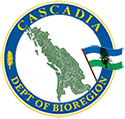Cascadia in Popular Culture
Bioregional Roots
On a sunny day in July, more than 100 individuals gathered at Evergreen State College in Olympia, Washington to help shape a positive future for the Cascadia bioregion. They met deliberatively, in a participatory process that included representatives from watersheds, towns, organizations, groups and species, examined challenges to the region, and explored strategies and goals to overcome them. Over that weekend, bioregional organizers, policy planners, feminists, anarchists and indigenous leaders gathered with the first Cascadia flag, bearing the stars and crescent, for what became the first ever, Cascadia Bioregional Congress, hosted in 1986.
Over the next ten years, these gatherings swelled by hundreds. Committees and forums were voluntarily created to address issues ranging from grassroots democracy, community building, forestry, recycling, nuclear concerns, to decentralized and local economics. Resolutions and statements were drafted and approved by a hybrid consensus model by the larger body and topics like direct action, inclusion of Indigenous and traditionally marginalized voices and groups, gender equality and safe organizing spaces were made central parts of this growing movement.
These meetings grew into the late nineties and were responsible for many of the early recycling, composting, gardening and community programs, as well as new media networks, and business cooperatives as individuals moved into leadership and government roles, implementing programs that cemented the Cascadia bioregion as a leader on many of these issues. Early pioneers included organizers like Earth Day founder Dennis Hayes and many others. By the mid 1990’s, groups like Cascadia Earth First, the Cascadia Forest Defenders, and Cascadia Wildlands formed to help protect our unique ecosystem – while Cascadia continued to grow academically through geology, environmental science and geography, and by a range of elected and business leaders in groups like the Pacific Northwest Economic Region, one of the largest examples of cross-border paradiplomacy in the world.

